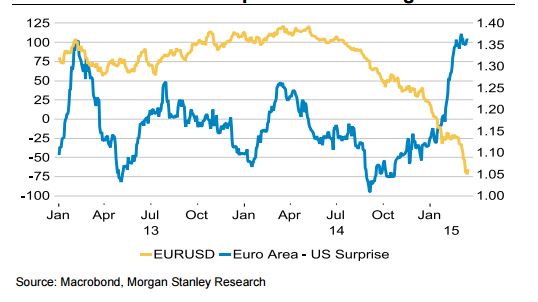Avoiding the 'Long Dollar' Band-Wagon
The dollar slumped this week in the wake of the US Federal Reserve’s latest note on interest rate policy.
How did the market react?
They piled back in and bought more dollars ensuring the US unit is ultimately unchanged against the pound sterling and euro as we head into the weekend.
What the events of the week show us is that that every man and his dog are willing to jump onto the ‘long dollar’ band-wagon.
However, there is one leading analyst telling us that this one-way bet on the dollar is not as attractive as it once was.
Caution is therefore urged.
In their latest ‘FX Pulse’ note to clients Morgan Stanley say that over recent weeks they have reduced their USD exposure.
“For the remaining USD long positions, we have tightened our stops,” the investment bank tells clients.
While many currency traders would instinctively point to the over-bought conditioning of the dollar index as being the key to shying away from buying dollars, Morgan Stanley argue that fundamentals lie at the heart of the matter.
“US growth related uncertainties have increased recently, which could have a material impact on FX trading over the next few weeks,” says Hans Redeker at MS.
We are told that the USD’s trading performance has become data dependent of late and with data weakness creeping in they see less scope for the USD to rally in the short term.
For those shorting the euro dollar rate notice must be taken of Eurozone data which has started to strengthen.
The all-important data surprises which tend to drive financial market movements could well be biased towards the Eurozone in coming weeks and months.
The obvious winner of such a scenario is the euro.
Below: EMU-US Economic Surprises Have Diverged
US GDP Slows – Fed Rate Hike Damaging
The timing of that first US Federal Reserve interest rate hike is still seen as being the key driver for the USD.
The argument being posed by Morgan Stanley is that markets have got ahead of themselves with just how soon that rate rise will occur.
We saw just how quickly the dollar fell in the wake of the March FOMC briefing in which hints of a later rate rise was possible.
The subsequent recovery confirms markets are unwilling to take the message on board.
Morgan Stanley’s Q1 GDP tracker has eased to 1.2%, and they believe this trend has impacted Fed thinking.
“An early rate hike at this stage carries bigger risks than in times of economic strength. There are FX implications here,” says Redeker.
The argument forwarded is that an early hike not supported by strong economic data leaves the equity market vulnerable to a major correction.
“Most of the equity rally witnessed since March 2009 has been driven by a liquidity-induced increase in valuation. Taking liquidity away and not compensating with an improved earnings outlook could take shares lower,” says Redeker.
It is suggested the Fed seems aware of these risks, given its latest statement which opened the door for hikes, but left the timing data-dependent.
The net result of these observations is Morgan Stanley have decided to close their EUR put spread, which was in the money, in case there is a further EUR correction from here.
Long Term? Still Bullish
That said, the longer-term picture at the investment bank remains pro-USD.
So while the rally is expected to stall in the closer time frames, the big picture should not be mistaken.
“We stick to our medium-term bullish USD view, but see scope for a pause in the near term, given the more dovish shift in the Fed,” say MS.
Indeed, strategically analysts confirm they wouldn’t be short USD, but prefer relative value trades in this environment.






